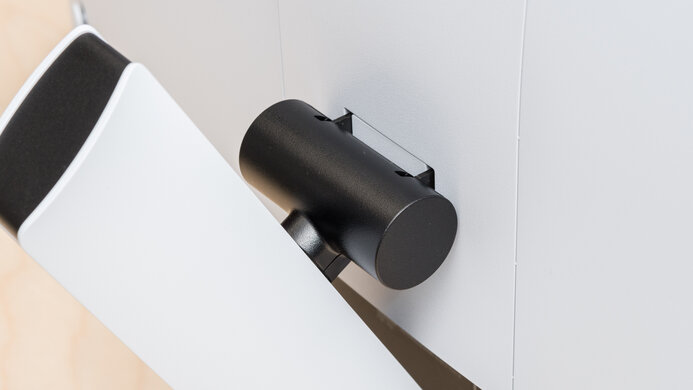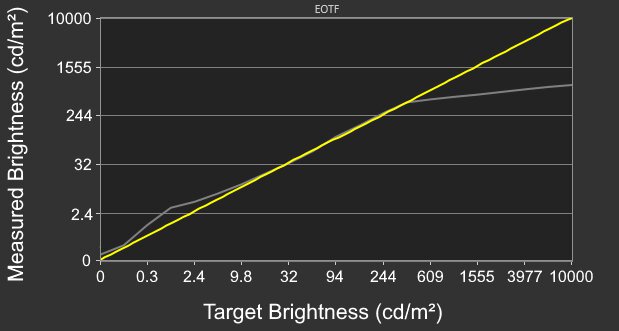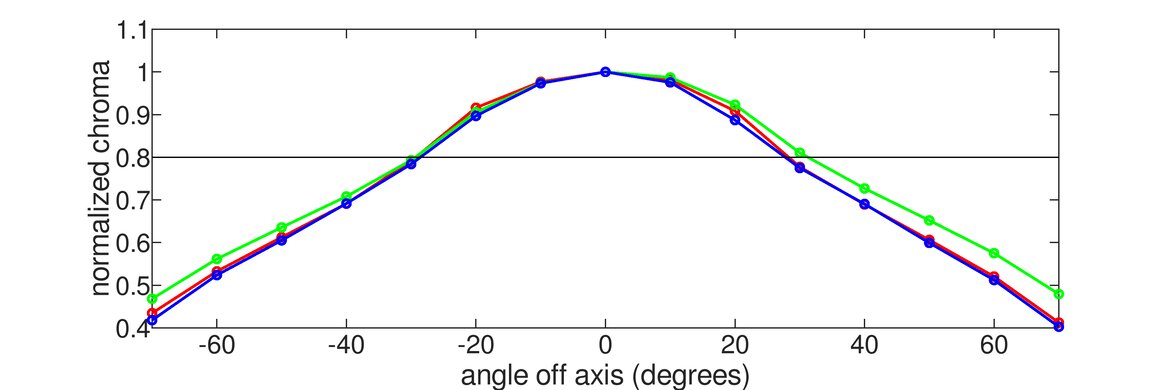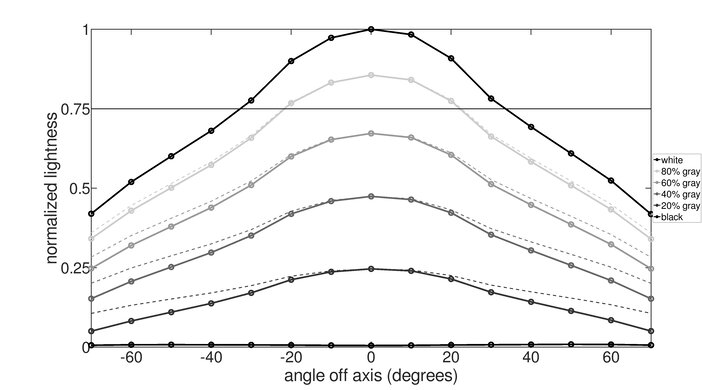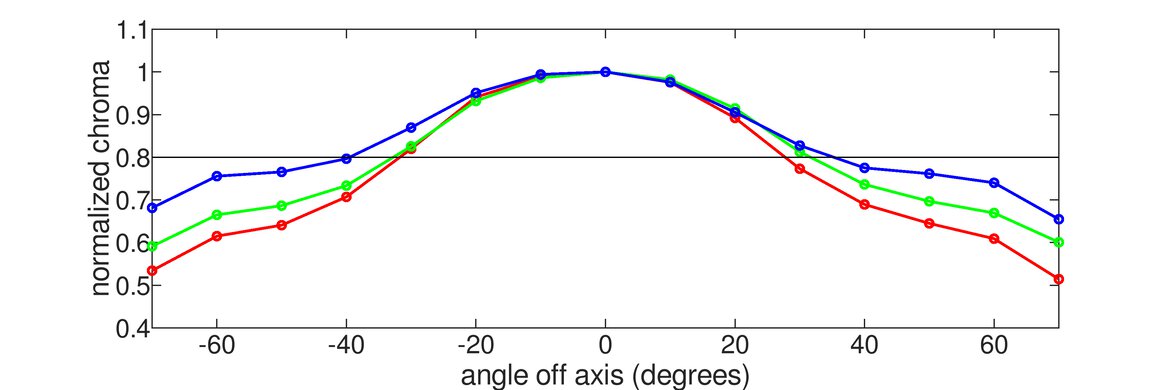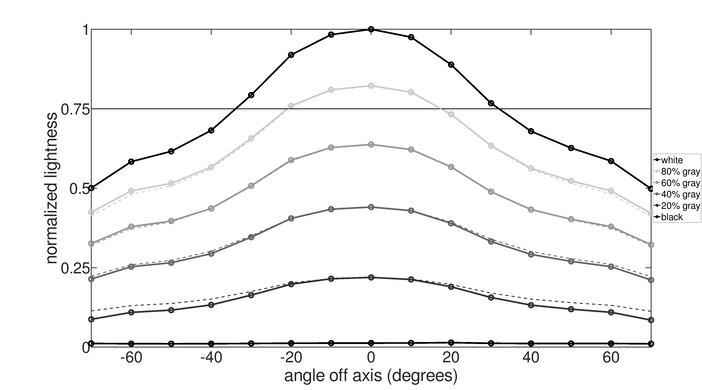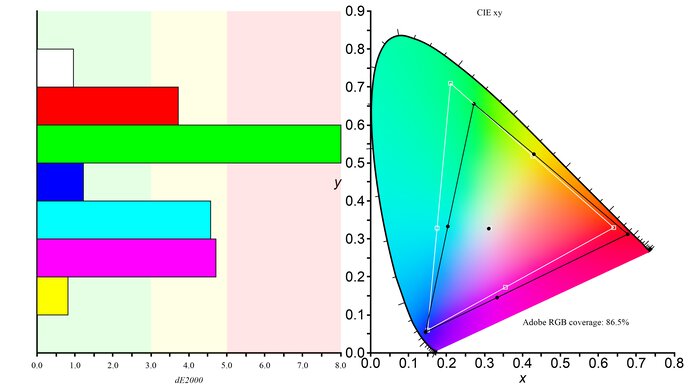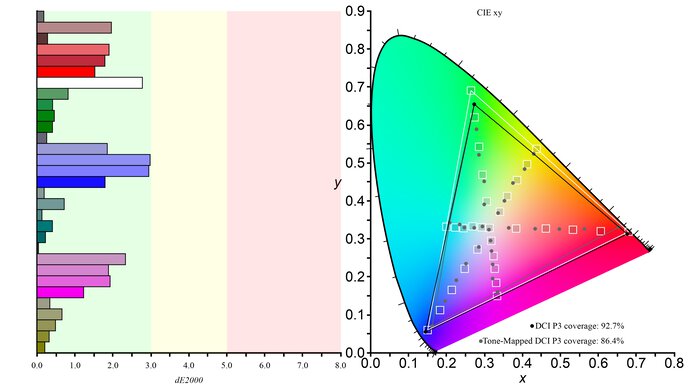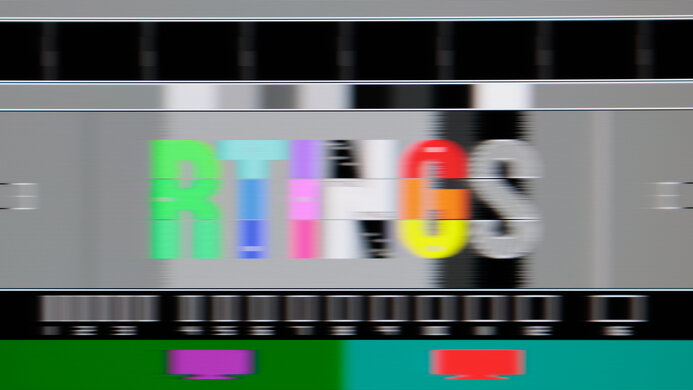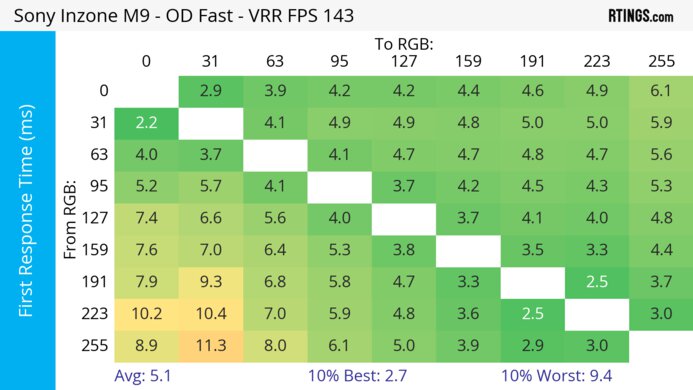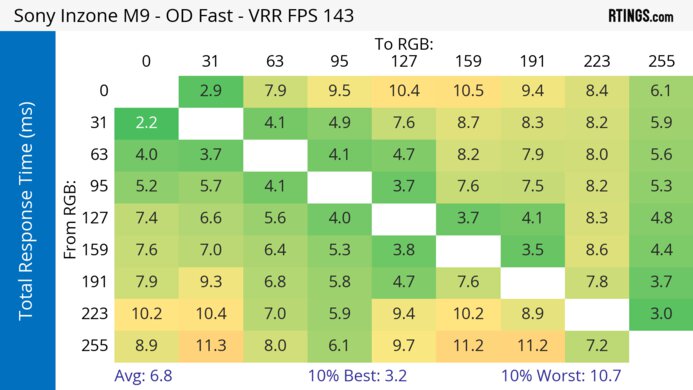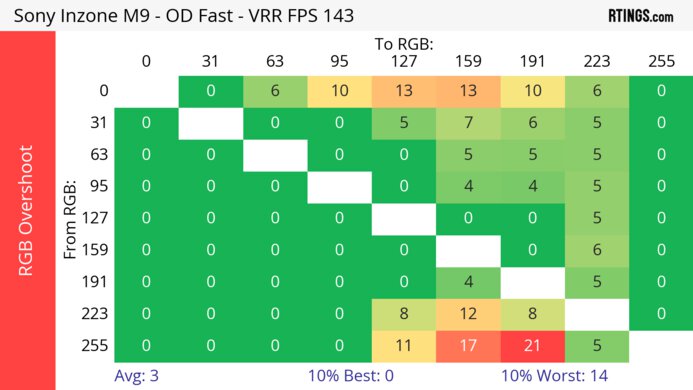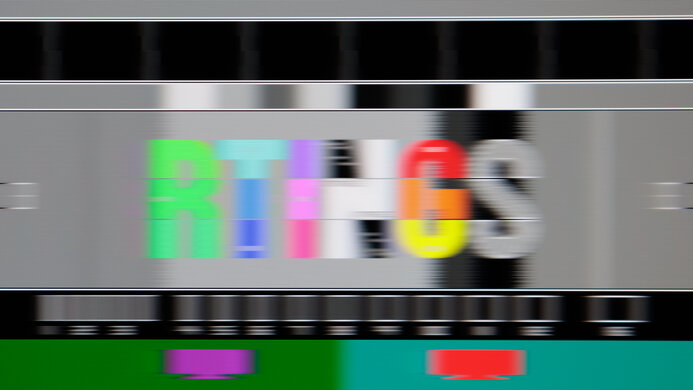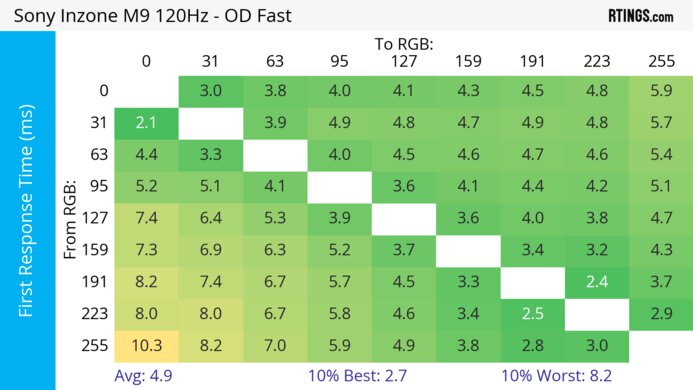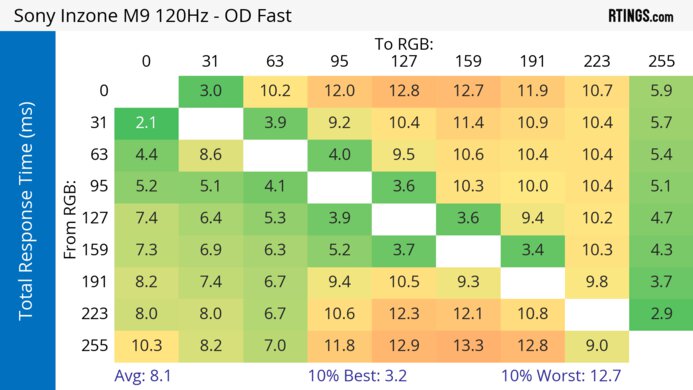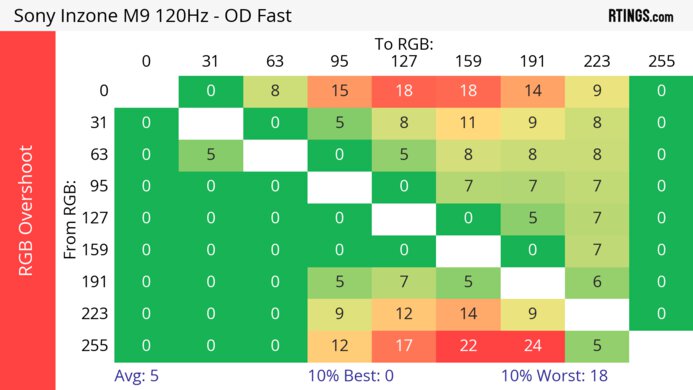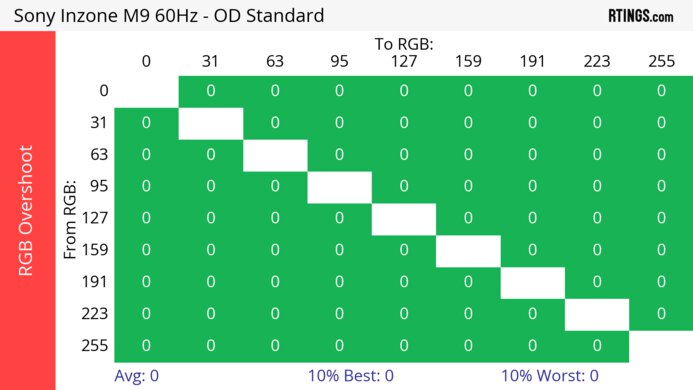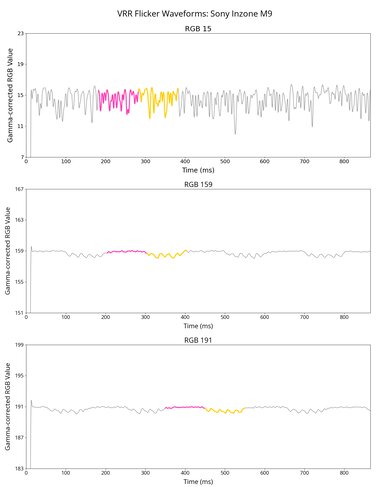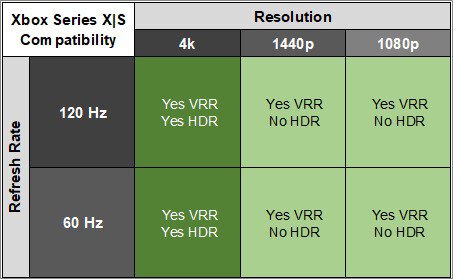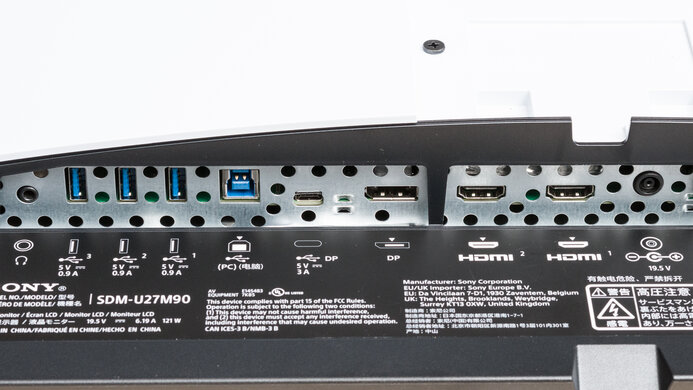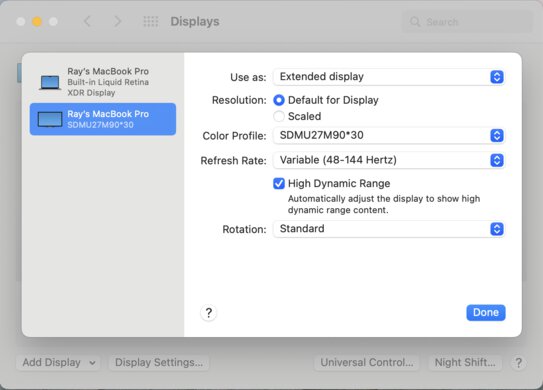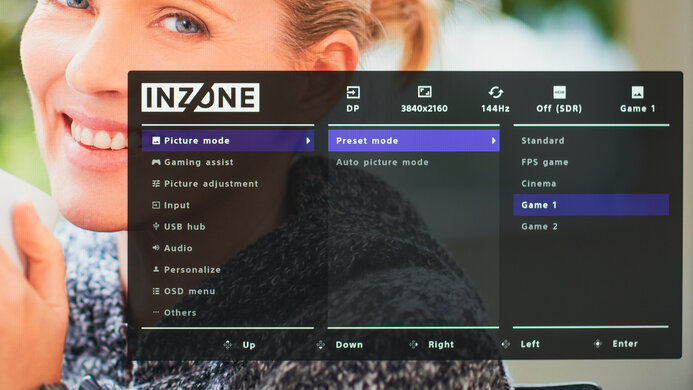The Sony INZONE M9 is a 27-inch, 4k gaming monitor with a 144Hz refresh rate. It's part of Sony's INZONE lineup that features other products like the Sony INZONE H9 Wireless and is a higher-end monitor than the Sony INZONE M3. It has typical gaming features like HDMI 2.1 bandwidth, VRR support to reduce screen tearing, and full-array local dimming. Sony also advertises it as being 'Perfect for PS5' as it has features with the console that other monitors don't have, like Auto HDR Tone Mapping, and it has design similarities with the PS5, so it gives your setup a uniform look.
Our Verdict
The Sony INZONE M9 is decent for PC gaming. Although its 144Hz refresh rate isn't high for competitive PC gaming, it's still fine for casual gamers, and it has VRR support to reduce screen tearing. It also has low input lag for a responsive feel, and motion looks sharp, but there's more blur at lower refresh rates. Even though it has a low native contrast ratio, blacks still look deep with the local dimming feature enabled, but small highlights are muted in HDR.
- 144Hz refresh rate and VRR support.
- Low input lag.
- Fast response time at high refresh rates.
- Full-array local dimming improves contrast.
- Low native contrast ratio.
- More blur at lower refresh rates.
- Blooming around bright objects.
The Sony INZONE M9 is impressive for console gaming. It has features with the PS5 that other monitors don't have, like Auto HDR Tone Mapping, and it also takes full advantage of the Xbox Series X|S. It has a high 4k resolution for detailed images, and it has a full-array local dimming feature that helps it display deep blacks, but there's blooming around bright objects. In terms of gaming, it has low input lag for a responsive feel, and motion looks sharp at most refresh rates, except there's more blur at lower refresh rates.
- Low input lag.
- Fast response time at high refresh rates.
- HDMI 2.1 bandwidth for consoles.
- Full-array local dimming improves contrast.
- Made for PS5 features.
- Low native contrast ratio.
- More blur at lower refresh rates.
- Blooming around bright objects.
The Sony INZONE M9 is great for the office. The large, high-resolution screen makes it easy to multitask, as you can easily work with multiple windows open, resulting in fantastic text clarity. It has good visibility in bright rooms thanks to its high brightness and good reflection handling, so glare isn't an issue. Sadly, it has limited ergonomics, so it's difficult to adjust it to an ideal viewing position, and although it has USB-C power, it's limited to 15W of power delivery. It even has a KVM switch, but it only works after a firmware update.
- Bright enough to fight glare.
- Good reflection handling.
- Fantastic text clarity.
- KVM switch works after firmware update.
- Limited ergonomics.
The Sony INZONE M9 is decent for media creators. The large, high-resolution screen makes it easy to see more of your workflow at once. Unfortunately, it has oversaturated colors before calibration, so you need to calibrate it for the best accuracy, but it displays a wide range of colors once you do. It has an okay local dimming feature that helps improve the contrast ratio, but it has blooming around bright objects, which isn't ideal for editing content in dark rooms. It also has limited ergonomics, which is disappointing for sharing your screen with others.
- Bright enough to fight glare.
- Full-array local dimming improves contrast.
- Good reflection handling.
- Fantastic text clarity.
- Low native contrast ratio.
- Limited ergonomics.
- Colors are oversaturated before calibration.
The Sony INZONE M9 has great brightness. It's bright enough to fight glare and also delivers an impactful HDR experience, but small highlights are muted in HDR.
- Bright enough to fight glare.
- Large highlights get bright in HDR.
- Small highlights are dim with local dimming.
The Sony INZONE M9 has a good response time. For the most part, motion looks sharp, but there's more inverse ghosting and blur at lower refresh rates.
- Fast response time at high refresh rates.
- More blur at lower refresh rates.
The Sony INZONE M9 has okay HDR picture quality. Although it has a low native contrast ratio, it has a full-array local dimming feature to improve the picture quality in dark scenes. That said, it has blooming around bright objects, and it doesn't display very bright colors well.
- Full-array local dimming improves contrast.
- Blooming around bright objects.
The Sony INZONE M9 has okay SDR picture quality. It displays a wide range of colors, but it has a low contrast ratio, so blacks look gray without its local dimming feature.
- Displays wide range of SDR colors.
- Low native contrast ratio.
The Sony INZONE M9 has decent color accuracy. Since it lacks an sRGB mode and has oversaturated colors before calibration, you need to calibrate it for the best accuracy.
- Colors are oversaturated before calibration.
Performance Usages
Changelog
- Updated Feb 21, 2025: We've converted this review to Test Bench 2.0.1. This includes a new test result for DisplayPort 2.1 Transmission Bandwidth.
-
Updated Jan 24, 2025:
Added that the Sony INZONE M9 II gets even brighter in HDR.
- Updated Aug 12, 2024: Confirmed that its KVM switch works after a firmware update.
- Updated Aug 09, 2024: Updated text throughout the review according to Test Bench 2.0, mainly in the Verdict and Motion sections.
Check Price
Differences Between Sizes And Variants
We tested the 27-inch Sony INZONE M9, which is the only size available, and the results are only valid for this monitor. As a part of Sony's INZONE monitor lineup, it sits above the Sony INZONE M3, and you can see the differences between them below.
| Model | Size | Panel Type | Resolution | Max Refresh Rate | HDMI 2.1 |
|---|---|---|---|---|---|
| M9 | 27" | IPS | 4k | 144Hz | Yes |
| M3 | 27" | IPS | 1080p | 240Hz | No |
Our unit was manufactured in June 2022, and you can see the label for our unit here.
Popular Monitor Comparisons
The Sony INZONE M9 is a 4k, 27-inch gaming monitor that's mainly designed for use with gaming consoles, specifically the PS5. It has features with the PS5 that other monitors don't have, like Auto HDR Tone Mapping, and its design even shares similarities with the console. Although there are other 4k gaming monitors that work well with consoles, this one is really meant to complement the PlayStation. If that isn't as important for you, you can go for other monitors with better motion handling or picture quality, like the Acer Nitro XV275K P3biipruzx.
Check out our recommendations for the best 4k 144Hz monitors, the best monitors for PS5/PS5 Pro, and the best 4k gaming monitors.
The LG 27GP950-B and the Sony INZONE M9 are both 4k, 27-inch gaming monitors. The LG has much better accuracy out of the box, and colors aren't oversaturated, so it's a better choice for anyone looking for an accurate image. The LG also has better ergonomics, so it's easier to place it in an ideal viewing position. The LG also has slightly faster response times, especially if you're gaming at lower refresh rates, including 120Hz or 60Hz gaming from a console.
The Sony INZONE M9 and the Sony INZONE M9 II are extremely similar 27-inch 4k gaming monitors with full-array local dimming. The M9 II is the better option for most gamers, as its local dimming system is slightly better at preserving details in dark scenes than the original M9 and looks slightly smoother with its higher 160Hz refresh rate. However, the original M9 looks less cloudy, particularly with static scenes, so you may prefer it if you find cloudiness or blooming distracting, particularly in slower scenes.
The Sony INZONE M9 and the Samsung Odyssey G70D S32DG70 are 4k gaming monitors with a few differences. The Sony has better picture quality because it has a full-array local dimming feature that does a better job at improving the picture quality in dark scenes than the edge-lit local dimming on the Samsung. The Sony also gets brighter because of this, making it the better choice for use in well-lit rooms. On the other hand, the Samsung monitor is more accurate out-of-the-box, which is something to consider for content creation.
Although the Sony INZONE M3 and the Sony INZONE M9 are part of the same lineup, they're very different monitors. The M9 is designed with console gaming in mind because it has a 4k resolution with HDMI 2.1 bandwidth, allowing you to take full advantage of the PS5 and Xbox Series X. On the other hand, the M3 is better for PC gamers because it has a higher 240Hz refresh rate, and with a 1080p resolution, it's easier for your graphics card to reach its max refresh rate.

We buy and test more than 30 monitors each year, with units that we buy completely on our own, without any cherry-picked units or samples. We put a lot into each unbiased, straight-to-the-point review, and there's a whole process from purchasing to publishing, involving multiple teams and people. We do more than just use the monitor for a week; we use specialized and custom tools to measure various aspects with objective data-based results. We also consider multiple factors before making any recommendations, including the monitor's cost, its performance against the competition, and whether or not it's easy to find.
Test Results

The Sony INZONE M9 Monitor has a unique design and a gamer aesthetic. The front of the monitor has a simple design, and the back shares many similar design elements with the PS5 and the other Sony INZONE products, like the Sony INZONE H7 Wireless. The stand has three legs that support the monitor like a tripod.
The ergonomics are disappointing. It's hard to adjust the screen for others, and even its height adjustment is limited. The back of the monitor is pretty plain, with an RGB light strip near the top of the display and a hook on the back of the stand for basic cable management.
The height adjustment is at an angle, so the total thickness varies depending on the height of the display. At the lowest point, the total thickness is about 9.7" (24.7 cm), and at the highest setting, it's about 8.3" (21.1 cm), so the distance between the user and the screen varies as you adjust the height.
The local dimming feature is just okay. It has 96 zones in an 8x12 array. The zones are still a bit too large to allow for precise dimming in dark scenes, and the algorithm tends to turn on more zones on than needed. There's some noticeable blooming around bright objects, but very little black crush because of this. It isn't very good for subtitles, though, as it tends to light up large areas of the screen. It also keeps up with fast-moving content well, so you don't see a trailing bright edge behind fast-moving, bright objects.
It's an okay implementation of local dimming, but it's limited by the relatively small number of zones, and because it tends to turn on more zones than necessary, the impact is limited. You can see two real scene videos of the local dimming feature in action and from an angle.
If you want a 4k monitor with similar features and a better local dimming feature, look into the Cooler Master Tempest GP27U.
This monitor has great brightness in SDR. It's bright enough to overcome glare in a bright room, and there's no variation in brightness between content. That said, if you want something even brighter, look into the INNOCN 27M2V.
These results are from after calibration in the 'Game 1' Picture Mode with Brightness set to max and Local Dimming set to 'High.'
The HDR brightness is great. It gets bright enough for an impactful HDR experience, and while large highlights pop, small highlights are dimmed. The PQ EOTF follows the target curve well for the most part, but with a slow roll-off at the peak brightness, it doesn't let highlights get the brightest they can.
These results are from the 'Game 1' Picture Mode with HDR enabled, Local Dimming set to 'High,' and Brightness set to max. The picture modes available depend on the source, as 'Game 1' is the only mode available with a PC, and 'Cinema' is the only mode with a Blu-ray player. If you're looking for a monitor that gets even brighter in HDR, check out the Sony INZONE M9 II.
The horizontal viewing angle is just alright. Although it has an IPS panel, the image washes out from wide angles, but it's still fine if you want to use it for a co-op gaming session with your friend sitting right next to you.
The vertical viewing angle is decent, but the image washes out if you're looking at it from above or below.
This monitor has passable black uniformity. With local dimming disabled, the entire screen is cloudy, and there are a few bright spots throughout the screen where the backlight isn't quite even. With local dimming enabled on 'High,' there's noticeable blooming around bright objects, but the uniformity is better besides that.
The Sony M9 has okay accuracy before calibration. It doesn't have an sRGB mode, so colors are way too oversaturated, and there are some inaccuracies in most colors. However, the white balance is excellent, and the color temperature is close to the 6500K target with the Color Temperature setting 'Warm.' Even gamma follows that target sRGB curve well, but dark scenes are too dark.
The accuracy after calibration is fantastic. The main advantage of calibrating it is that colors aren't oversaturated anymore, and other inaccuracies are hard to see.
The SDR color gamut is fantastic. It displays all of the sRGB color space used by most desktop and web content. It has good coverage of the wider Adobe RGB color space, but it can't display the full range of greens in that color space, so it isn't ideal for publishing.
The HDR color gamut is great. It has fantastic coverage of the DCI-P3 color space used by the vast majority of current HDR content. Its coverage of the wider Rec. 2020 color space is limited, though, but there aren't many tone mapping issues with either color space.
The Sony INZONE M9 has good reflection handling as the coating significantly reduces the intensity of bright lights. Thanks to its high peak brightness, you won't have any issues using it in a well-lit room.
Oddly, the max refresh rate over HDMI is limited to 120Hz, even if the HDMI ports have enough bandwidth for a 144Hz signal. Even forcing a 144Hz refresh rate doesn't work, so the only way to get the max refresh rate is over DisplayPort.
| NVIDIA | VRR Min | VRR Max |
| DisplayPort | <20Hz | 144Hz |
| HDMI | <20Hz | 144Hz |
| AMD | VRR Min | VRR Max |
| DisplayPort | <20Hz | 144Hz |
| HDMI | N/A | N/A |
On top of supporting FreeSync VRR and G-SYNC compatibility, it also supports HDMI Forum VRR.
| Refresh Rate | CAD Heatmap | RT Chart | Pursuit Photo |
| 143 | Heatmap | Chart | Photo |
| 120 | Heatmap | Chart | Photo |
| 100 | Heatmap | Chart | Photo |
| 80 | Heatmap | Chart | Photo |
| 60 | Heatmap | Chart | Photo |
The motion handling is good across the VRR range. Although there isn't much motion blur, the 'Fast' overdrive setting has inverse ghosting as the refresh rate rate drops. The 'Standard' overdrive is better if you want more consistency across the VRR range, but it has more blur.
The refresh rate compliance is good. Although its response time isn't fast enough to make full color transitions at its max refresh rate, it's better at lower refresh rates.
| Overdrive Mode | CAD Heatmap | RT Chart | Pursuit Photo |
| Standard | Heatmap | Chart | Photo |
| Fast | Heatmap | Chart | Photo |
| Faster | Heatmap | Chart | Photo |
The CAD at the max refresh rate of 144Hz is very good. Motion looks sharp with the 'Fast' overdrive, as it has less blur than 'Standard' and less inverse ghosting than 'Faster.'
Unfortunately, this monitor doesn't have an optional backlight strobing feature, which is commonly known as black frame insertion.
There isn't any noticeable VRR flicker with changing frame rates, which is fantastic for gaming. However, you need to update the firmware to M009 and newer to make sure you aren't experiencing any issues. On previous firmware, there were some VRR flicker issues, particularly with the PS5. After playing certain games for a few minutes, the monitor sometimes started flickering severely, even if you closed the game and changed sources. This issue occurred frequently with Marvel's Spider-Man: Miles Morales on the PS5. However, this doesn't happen after updating the firmware.
The Sony INZONE M9 has very low input lag, ensuring a responsive gaming or desktop experience at any refresh rate.
The Sony M9 Monitor is fully compatible with everything the PS5 supports. It also supports a few features specific to the PS5, including Auto HDR Tone Mapping, which optimizes your HDR experience to match the capabilities of your display.
It supports USB-C and power delivery, but it doesn't deliver enough power to charge a laptop while you're using it.
This monitor has a few extra features, including:
- Crosshair: Adds a virtual crosshair to any game that can't be detected by the game.
- FPS Counter: Shows the current frame rate from the source.
- Black Equalizer: Adjusts gamma to make it easier to spot objects/players in dark scenes without adjust bright scenes.
It also has a KVM switch that makes it easy to switch between two sources and use the same keyboard and mouse connected to the monitor. However, you need to update the firmware to get it work.



